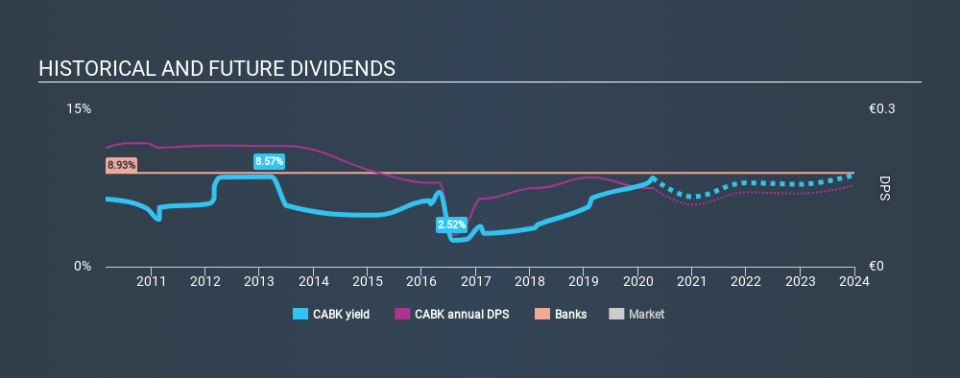Would CaixaBank, S.A. (BME:CABK) Be Valuable To Income Investors?

Is CaixaBank, S.A. (BME:CABK) a good dividend stock? How can we tell? Dividend paying companies with growing earnings can be highly rewarding in the long term. If you are hoping to live on the income from dividends, it's important to be a lot more stringent with your investments than the average punter.
In this case, CaixaBank likely looks attractive to investors, given its 8.5% dividend yield and a payment history of over ten years. It would not be a surprise to discover that many investors buy it for the dividends. Remember that the recent share price drop will make CaixaBank's yield look higher, even though recent events might have impacted the company's prospects. Some simple analysis can reduce the risk of holding CaixaBank for its dividend, and we'll focus on the most important aspects below.
Click the interactive chart for our full dividend analysis
Payout ratios
Companies (usually) pay dividends out of their earnings. If a company is paying more than it earns, the dividend might have to be cut. As a result, we should always investigate whether a company can afford its dividend, measured as a percentage of a company's net income after tax. In the last year, CaixaBank paid out 57% of its profit as dividends. This is a healthy payout ratio, and while it does limit the amount of earnings that can be reinvested in the business, there is also some room to lift the payout ratio over time.
Remember, you can always get a snapshot of CaixaBank's latest financial position, by checking our visualisation of its financial health.
Dividend Volatility
From the perspective of an income investor who wants to earn dividends for many years, there is not much point buying a stock if its dividend is regularly cut or is not reliable. CaixaBank has been paying dividends for a long time, but for the purpose of this analysis, we only examine the past 10 years of payments. The dividend has been cut on at least one occasion historically. During the past ten-year period, the first annual payment was €0.23 in 2010, compared to €0.15 last year. This works out to be a decline of approximately 4.1% per year over that time. CaixaBank's dividend has been cut sharply at least once, so it hasn't fallen by 4.1% every year, but this is a decent approximation of the long term change.
When a company's per-share dividend falls we question if this reflects poorly on either external business conditions, or the company's capital allocation decisions. Either way, we find it hard to get excited about a company with a declining dividend.
Dividend Growth Potential
With a relatively unstable dividend, it's even more important to evaluate if earnings per share (EPS) are growing - it's not worth taking the risk on a dividend getting cut, unless you might be rewarded with larger dividends in future. Strong earnings per share (EPS) growth might encourage our interest in the company despite fluctuating dividends, which is why it's great to see CaixaBank has grown its earnings per share at 19% per annum over the past five years. Earnings per share have been growing rapidly, but given that it is paying out more than half of its earnings as dividends, we wonder how CaixaBank will keep funding its growth projects in the future.
Conclusion
To summarise, shareholders should always check that CaixaBank's dividends are affordable, that its dividend payments are relatively stable, and that it has decent prospects for growing its earnings and dividend. First, we think CaixaBank has an acceptable payout ratio. We were also glad to see it growing earnings, but it was concerning to see the dividend has been cut at least once in the past. In summary, we're unenthused by CaixaBank as a dividend stock. It's not that we think it is a bad company; it simply falls short of our criteria in some key areas.
It's important to note that companies having a consistent dividend policy will generate greater investor confidence than those having an erratic one. Still, investors need to consider a host of other factors, apart from dividend payments, when analysing a company. For instance, we've picked out 3 warning signs for CaixaBank that investors should take into consideration.
We have also put together a list of global stocks with a market capitalisation above $1bn and yielding more 3%.
If you spot an error that warrants correction, please contact the editor at editorial-team@simplywallst.com. This article by Simply Wall St is general in nature. It does not constitute a recommendation to buy or sell any stock, and does not take account of your objectives, or your financial situation. Simply Wall St has no position in the stocks mentioned.
We aim to bring you long-term focused research analysis driven by fundamental data. Note that our analysis may not factor in the latest price-sensitive company announcements or qualitative material. Thank you for reading.

 Yahoo Finance
Yahoo Finance 
